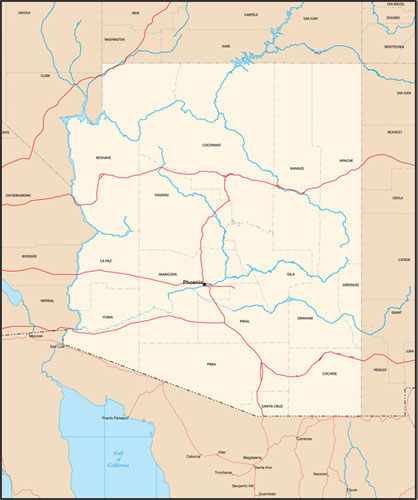Sign up for the Family Tree Newsletter Plus, you’ll receive our 10 Essential Genealogy Research Forms PDF as a special thank you!
Get Your Free Genealogy Forms
"*" indicates required fields
Francisco Vasquera de Coronado came to Arizona in 1540 in search of the “seven cities of gold.” The Zuni Indians pointed him west, hoping the Spanish would leave their area, which had already been inhabited by native people for some 12,000 years. Other tribes from Arizona include the Cochise, Anasazi, Mogollon, Apache, Navajo and Hopi. The Hopi village of Old Oraibi is the oldest continuously inhabited place in the United States, dating back more than 1,000 years.
Though the Zuni didn’t entirely detour the Spanish, Arizona was slower to be colonized than neighboring New Mexico. Tucson wasn’t founded until 1775, and the settlements were concentrated in the southern part of the state when Arizona became part of Mexico (as a part of the state of Sonora) with independence in 1821. The Treaty of Guadalupe Hidalgo in 1848 ended the Mexican-American War and closed the long chapter of Spanish-Mexican rule north of the Gila River in Arizona. The rest of present-day Arizona was added to the United States with the Gadsden Purchase in 1853. The Arizona Territory was split off from the New Mexico Territory in 1863, but statehood didn’t follow until 1912 — the last of the contiguous United States.
Today’s Arizona largely sprang up after World War II, as Americans flocked to the sun. Between 1950 and 1990 the population of Phoenix increased from 100,000 to 980,000. In 1960, the Del Webb Corporation, created Sun City, launching Arizona as a retirement haven.
RESEARCH TIPS
- Although Arizona is a large state, it’s divided into just 15 counties.
- Several published indexes to Mexican censuses cover the area that’s now Arizona: 1801 for Pimeria Alta; 1831 for Tucson, Tubac and Santa Cruz; and 1852 for Pimeria Alta.
- Check repositories for Arizona, New Mexico, and Mexico for early years.
- A good place to begin is the Arizona State Library,
- Archives, and Public Records website http://www.lib.az.us.
CENSUS RECORDS
- Federal census: 1860, 1870, 1880, 1900, 1910, 1920
- Federal mortality schedules: 1870, 1880
- Territorial census: 1864, 1866, 1867, 1869, 1871, 1872, 1882
GENERAL RESOURCES
- Arizona Gathering II, 1950-1969; an Annotated Bibliography by Donald M. Powell (University of Arizona Press, 1973)
- Arizona Genealogical and Historical Research Guide: Early Sources for Southern Arizona by Barbara Baldwin Sayer (Arizona State Genealogical Society, 2006)
- Arizona, the History of the Frontier State by Rufus Kay Wyllys (Hobson & Herr, 1950)
- Arizona Research Outline by the Church of Jesus Christ of Latter-day Saints (online at http://www.familysearch.org/eng/search/RG/guide/missouri.asp)
- Directory of Churches and Religious Organizations in Arizona from the US Works Progress Administration (Arizona Statewide Archival and Records Project, 1940)
- Genealogical Guide to Arizona and Nevada by Joyce V. Hawley Spiros (Verlene Publishing, 1983)
- Farish, Arizona Historian, 8 vols., by Thomas Edwin Farish (The Filmer Brothers Electrotype Company, 1915-1918)
- Mormons and Their Neighbors: An Index to Over 75,000 Biographical Sketches from 1820 to the Present, 2 vols., compiled by Marvin E. Wiggins (Harold B. Lee Library, Brigham Young University, 1984)
- Newspapers and Periodicals of Arizona, 1859-1911 by Estelle Lutrell (University of Arizona, 1950)
- Spanish & Mexican Records of the American Southwest: A Bibliographical Guide to Archive and Manuscript Sources by Henry Putney Beers (University of Arizona Press, 1979)
- Surname Index for the Arizona Sentinel, 1875-1905 from the Genealogial Society of Yuma, Arizona, and Arizona Sentinel (Genealogical. Society of Yuma, Arizona, 1997)
Return to the main Arizona page
From the Family Tree Sourcebook
Also available: the State Research Guide Book, State Research Guides CD and The Researcher’s Guide to American Genealogy.
ADVERTISEMENT

